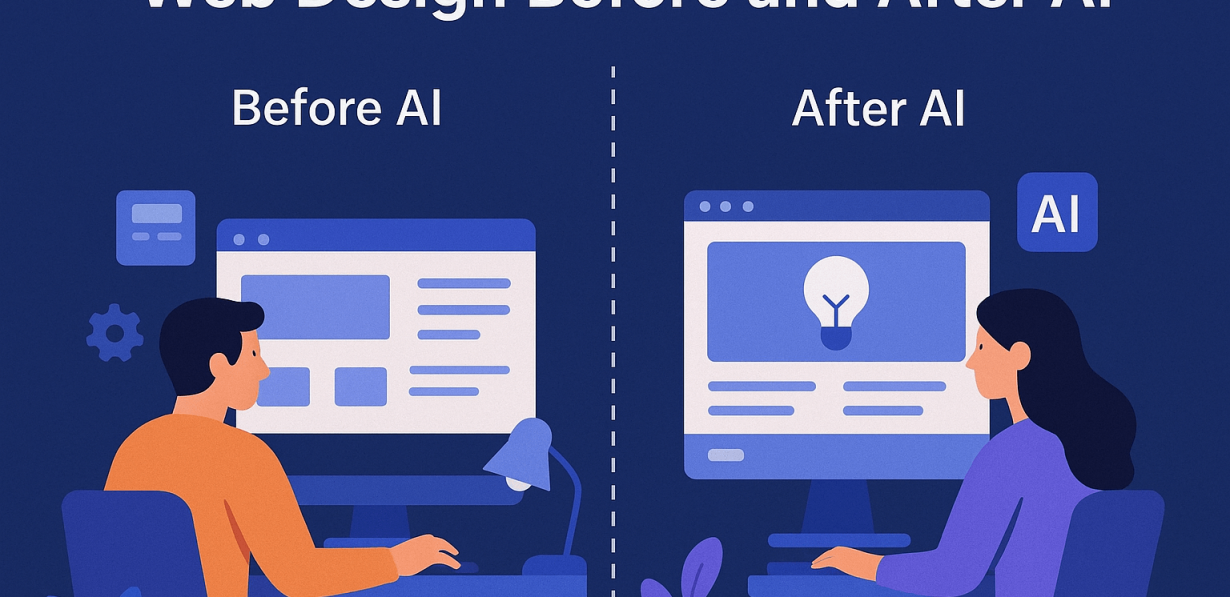Web Design Elevating Design Through Training Design Before and After AI: How Developers’ Mindsets, Strategies, and Optimization Changed Elevating Design Through Training Forever

Introduction: A Shift in the Digital Design Universe
The world of web design has gone through many transformations—HTML tables gave way to CSS grids, Flash animations evolved into interactive JavaScript experiences, and responsive design became standard. But the arrival of AI has been the single biggest game-changer in how developers think, plan, and execute their projects.
Before AI, web design was an intensely manual process, demanding hours of planning, coding, and testing. After AI, design has become faster, more personalized, and deeply integrated with GEO (Geographical Optimization), AEO (Answer Engine Optimization), and SEO (Search Engine Optimization) from the very beginning.
In this 1000-word post, we’ll explore how developers approached web design before AI, how their strategies evolved after AI, and why AI-powered GEO, AEO, and SEO optimization is now the new standard.
Web Design Before AI: Manual Mastery and Structured Thinking
1. Planning Was a Long Road
Before AI, every web design project started with a deep dive into client needs, target audiences, and brand guidelines. Developers and designers worked together to create wireframes, often on tools like Adobe Photoshop or Sketch. Every pixel was carefully placed, and even minor changes meant revisiting design files.
GEO Factor (Before AI): Developers had to create multiple site versions for different regions, often duplicating entire codebases for language and content variations.
AEO Factor (Before AI): Barely considered. Voice search and answer engines were not priorities; most sites were built for traditional keyword-based search.
SEO Factor (Before AI): Usually added after the design was complete. Metadata, image alt text, and keywords were inserted in the final stages—not during initial planning.
2. Coding Everything by Hand
The pre-AI developer relied heavily on manual coding. HTML, CSS, JavaScript—and sometimes jQuery—were used to create layouts, animations, and interactivity. Testing was manual, too, requiring hours of device-by-device checks.
Challenge: A simple website could take weeks or months to build. If a client wanted a multilingual, location-specific, and SEO-friendly site, the work multiplied significantly.
3. Content as a Separate Stage
Developers did not usually write copy; they waited for content teams to deliver text and images. This often caused delays because SEO content and design rarely evolved together.
4. Testing and Optimization Were Slow
Before AI-powered analytics, A/B testing required significant time and user traffic. Developers had to manually analyze heatmaps and user data, then make incremental improvements.
Web Design After AI: Speed, Personalization, and Optimization from Day One
1. Instant Prototypes and Layout Suggestions
AI-powered design tools like Figma AI, Framer AI, and Uizard can transform a text prompt into a working web prototype in minutes. Developers now think more strategically about what to build rather than how to start building it.
GEO Advantage: AI can instantly suggest localized layouts, languages, and color schemes tailored to different regions.
AEO Advantage: Sites can be structured from the start to answer voice queries and appear in featured snippets.
SEO Advantage: AI suggests keyword placement, meta descriptions, and schema markup while designs are being created—not after launch.
2. AI-Assisted Code Generation
With tools like GitHub Copilot and ChatGPT Code Interpreter, developers can generate HTML, CSS, React, or Vue components instantly. AI also helps debug and optimize performance in real time.
Impact: Instead of worrying about syntax, developers focus on functionality, UX, and conversion goals.
3. Content Creation Integrated with Design
AI tools can now create copy, images, and even videos in one workflow. A developer can design a hero section and instantly fill it with SEO-friendly, GEO-targeted, and AEO-optimized content without waiting for separate departments.
4. Dynamic Personalization
Modern AI websites adjust in real time based on user behavior and location. For example:
-
A visitor from Tokyo sees Japanese language and local offers.
-
A mobile user gets simplified navigation for faster interaction.
-
A returning visitor sees personalized product recommendations.
5. Continuous Optimization with AI Analytics
AI doesn’t just help with the launch—it keeps working afterward. Using AI-driven analytics, websites now auto-optimize layouts, CTAs, and content based on live user data. GEO, AEO, and SEO adjustments happen continuously without full redesigns.
GEO, AEO, and SEO After AI: The New Norm
GEO (Geographical Optimization)
-
AI detects user location automatically and adjusts content.
-
Language translation happens instantly without separate site builds.
-
Regional keyword targeting is built in from the start.
AEO (Answer Engine Optimization)
-
AI structures content so it ranks in Google’s Search Generative Experience (SGE) and Bing Chat.
-
Optimizes for natural, conversational queries.
-
Creates schema-rich pages that feed directly into voice assistants.
SEO (Search Engine Optimization)
-
AI integrates keyword research into the design stage.
-
Automatically generates meta tags, structured data, and internal linking.
-
Continuously updates content to match search trends.
Mindset Shift: From Builders to Strategists
Before AI:
-
Developers thought: “How do I build this from scratch?”
-
GEO, AEO, and SEO were separate stages.
-
Manual work consumed most of the project timeline.
After AI:
-
Developers think: “How can I make this smart, fast, and user-focused from day one?”
-
GEO, AEO, and SEO are core to every design decision.
-
AI handles repetitive tasks; humans focus on innovation.
The Future: AI as a Partner, Not a Replacement
AI will keep evolving, but it won’t replace developers. Instead, it will become an indispensable partner—handling automation, optimization, and personalization—while developers bring creativity, brand vision, and strategic thinking.
The real winners will be those who combine AI speed with human creativity to build websites that are not only beautiful but also globally optimized, answer-ready, and search-engine dominant.

